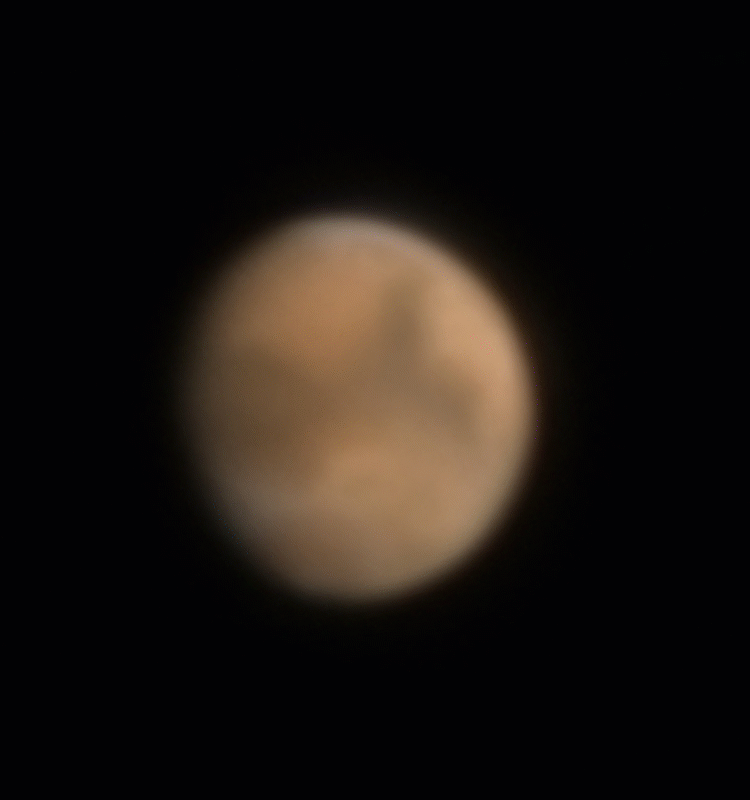Mars
Seeing "Red" - A Target of Extremes
Mars is the second closest planet to Earth (Venus is nearer), but that doesn’t mean it’s easy to observe. On the contrary…
In terms of percentage, it’s distance to us varies greatly precisely because our orbits are relatively close, as compared with, say, Jupiter, Saturn, and the other “gas giants” of Uranus and Neptune. For example, when our two worlds are on opposite sides of the Sun, the separation between us is significant, and because Mars is comparable in scale to Earth, the viewing is challenging to say the least.
On the other hand, when both planets are aligned and are positioned on the same side, the situation improves dramatically. This is especially true when, at the same time, Mars is near the perihelion of its orbit and Earth is near aphelion – extremes which place our planets in the most favorable proximity. As such, wonderful features can be observed and on a timescale revealing atmospheric and geographic changes: clouds, dust storms, the seasonal expansion and contraction of the polar caps. This is in additon to major features which remain virtually timeless as large scale erosion would take eons to erase their existence.

Magnificent Mars
Steve Wissler
The availability and affordability of CMOS video cameras cameras has forever changed the way we image the planets. The output from these devices is processed by software which renders the final image through a set of ingeneous tools.
The software first sifts through the movie file and mathematically rank orders the frames based on quality. The astronomer then tells the software how many of the frames to use for stacking - the next step in the process. Here, the program cleverly aligns the images and increases the signal-to-noise ratio on a pixel by pixel basis. The final step applies "wavelet sharpening" to coax out details by increasing contrast of structures detected on progressively finer scales of resolution.
One shot color (OSC) cameras make image capture very convenient versus monochrome models which would need three movies (one each exposed using a Green, Red, and Blue filter) and combine those to achieve similar appearance. However, a monochrome sensor with the same characteristics can outperform its RGB cousin because its inherent resolution in each color isn't impeded by a Bayer matrix, as explained on the Astro-photography page of this website.
For planets with fast rotation, like Jupiter and to a lesser degree Saturn, the length of the movie must be kept to a practical minimum lest the details blur due to rotation. A separate piece of software can effectively minimize or eliminate this deterimental effect.
Steve Wissler's detailed image shows the results of great execution from start to finish: expert use of the telescope, a modern camera and the software described above. Regarding the latter, a most surprising fact: the authors of those programs are amateurs and offer their creations for free.

Magnificent Mars
Steve Wissler
The availability and affordability of CMOS video cameras cameras has forever changed the way we image the planets. The output from these devices is processed by software which renders the final image through a set of ingeneous tools.
The software first sifts through the movie file and mathematically rank orders the frames based on quality. The astronomer then tells the software how many of the frames to use for stacking - the next step in the process. Here, the program cleverly aligns the images and increases the signal-to-noise ratio on a pixel by pixel basis. The final step applies "wavelet sharpening" to coax out details by increasing contrast of structures detected on progressively finer scales of resolution.
One shot color (OSC) cameras make image capture very convenient versus monochrome models which would need three movies (one each exposed using a Green, Red, and Blue filter) and combine those to achieve similar appearance. However, a monochrome sensor with the same characteristics can outperform its RGB cousin because its inherent resolution in each color isn't impeded by a Bayer matrix, as explained on the Astro-photography page of this website.
For planets with fast rotation, like Jupiter and to a lesser degree Saturn, the length of the movie must be kept to a practical minimum lest the details blur due to rotation. A separate piece of software can effectively minimize or eliminate this deterimental effect.
Steve Wissler's detailed image shows the results of great execution from start to finish: expert use of the telescope, a modern camera and the software described above. Regarding the latter, a most surprising fact: the authors of those programs are amateurs and offer their creations for free.
NASA,Public Domain
via Wikimedia Commons
Animation by SRO, Inc.







